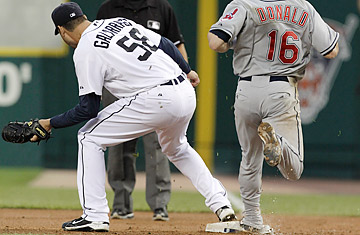
Detroit Tigers pitcher Armando Galarraga covers first base in what would have been the final out of his perfect game if not for a blown call by umpire Jim Joyce.
One of the more pleasant technical developments in sports over the last few years has been the emergence of the "Hawk-Eye" in tennis to call the lines. Tennis umpires now use the Hawk-Eye replay system to definitively settle all line disputes at Wimbledon, the U.S. Open and dozens of other professional tournaments around the world. A sophisticated system of 10 high-speed cameras are positioned around the court, and these cameras produce a 3-D image of the flight of each shot during a rally, allowing Hawk-Eye to calculate a billion equations that predict where the ball will hit the ground. Some players, including Roger Federer and Rafael Nadal, have occasionally questioned the accuracy of Hawk-Eye, but at this point there's almost universal agreement that the technology is a better solution than an umpire eyeballing the line from a distance and trying to determine whether a 140 mph serve was in or out. If Hawk-Eye had been around in the 70s, John McEnroe would probably be a much tamer person. It's hard to yell "are you serious?" at a computer animation. Mac was always a little touchy about the fact that some middle-aged amateur in a chair was judging the work of pros with lightning-quick reflexes and fantastic hand-eye coordination.
Hawk-Eye doesn't just make the calls; it improves the spectator experience. After a player challenges a call, all eyes dart to the big screen, as fans and players anxiously await the Hawk-Eye replay. There goes the flight. Will it fall in, or sail out? Here comes the moment of truth: oh, it's out, by a hair. Hawk-Eye provides a communal experience of anticipation, and adds to the drama of the game.
If Hawk-Eye can work in tennis, couldn't it be applied to another sport where the ball's landing spot on the field can determine the outcome of a game? A certain American pastime currently embroiled in an officiating controversy of its own? Clearly, the Hawk-Eye technology that makes "in" or "out" calls in tennis can make "fair" or "foul" calls in baseball. But can it make "safe" or "out" calls at first base, and thus have saved umpire Jim Joyce from the humiliation of costing Detroit's Armando Galarraga a perfect game on June 2? "The simple answer is yes," says Paul Hawkins, the British artificial intelligence Ph.D. who founded Hawk-Eye in 2001. "With the right technology, any dispute can be resolved definitively, accurately and immediately."
Over the last several years, Hawkins has been knocking on baseball's door, but the door to the big leagues hasn't opened. "We've never had a meeting with the right people," he says. "They've never showed any interest." (A spokesman for Major League Baseball says league officials attended a presentation about Hawk-Eye, given by the United State Tennis Association, at the 2007 U.S. Open.) To settle disputes at first base, Hawkins imagines a system that combines sensors on or inside the bag with tiny microphones that can pick up the "smack" sound of the first baseman catching the ball. The sensors and mikes can determine the precise moment when three crucial events take place: the runner's foot touching the bag, the first baseman's foot being planted on the bag, and the first baseman catching the ball. This information would be processed, and instantly displayed on the diamond vision for all to see: was he safe or out?
Other sports have responded coolly to Hawk-Eye. For soccer, the company developed a technology that could determine whether a ball crossed the goal line. But you won't see it at the World Cup: in March soccer's governing body, FIFA, said "we were all agreed that technology shouldn't enter football because we want football to remain human." The "we" in this case is the royal FIFA version, since many players and coaches would welcome it, precisely because human refs make horrible calls all the time. The sport can only pray that it avoids the disaster of 1966, when a disputed goal call during the final between England and West Germany still rankles Germans to this day.
Just as the error-plagued 2004 U.S. Open match between Jennifer Capriati and Serena Williams spurred tennis to consider adopting Hawk-Eye, Hawkins, and millions of baseball fans for that matter, hopes the perfect game fiasco forces baseball to at least start soliciting ideas from tech outfits. "That would give a stimulus for research and development organizations to spend a lot of effort trying to come up with a range of technological solutions," Hawkins says.
So please, pick up the phone, baseball. At least give Hawkins and his crew a call. Hawk-Eye has proved that a sport can survive, and even thrive, without human error. And human error is no fun at all. Just ask Jim Joyce.
